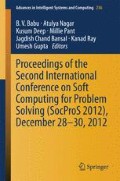Abstract
This paper describes fused floating point add–subtract operations and which is applied to the implementation of fast fourier transform (FFT) processors. The fused operations of an add–subtract unit which can be used both radix-2 and radix-4 butterflies are implemented efficiently with the two fused floating point operations. When placed and routed using a high-performance standard cell technology, the fused FFT butterflies are about may be work fast and gives user-defined facility to modify the butterfly’s structure. Also the numerical results of the fused implementations are more accurate, as they use rounding modes is defined as per user requirement.
Access this chapter
Tax calculation will be finalised at checkout
Purchases are for personal use only
References
Swartzlander Jr, E.E., Saleh, H.H.: FFT Implementation with Fused Foating-Point Operations. IEEE Transactions on Computers, Feb (2012)
Jongwook Sohn and Earl E. Swartzlander, Jr., “Improved Architectures for a Fused Floating-Point Add-Subtract Unit” IEEE Transactions on circuits and systems-I, Vol. 59, no. 11, 2012.
H. Saleh and E.E. Swartzlander, Jr., “A Floating-Point Fused Add-Subtract Unit”, Proc. IEEE Midwest Symp. Circuits and Systems (MWSCAS), pp. 519–522, 2008.
IEEE Standard for Floating-Point Arithmetic, ANSI/IEEE Standard 754–2008, Aug. 2008.
http://www.xilinx.com/FPGA_series
Lecture notes - Chapter 7 - Floating Point Arithmetic: http://pages.cs.wisc.edu/smoler/x86text/lect.notes/arith.flpt.html
All o/p are w.r.to XILINX Spartan-6 XC6SLX16 -CSG324C.
Stuart Franklin Oberman: Design Issues in High Performance Floating Point Arithmetic Units. Stanford University, Ph. D. Dissertation (1996).
Author information
Authors and Affiliations
Corresponding author
Editor information
Editors and Affiliations
Rights and permissions
Copyright information
© 2014 Springer India
About this paper
Cite this paper
Patil, I.A., Palsodkar, P., Gurjar, A. (2014). Floating Point-based Universal Fused Add–Subtract Unit. In: Babu, B., et al. Proceedings of the Second International Conference on Soft Computing for Problem Solving (SocProS 2012), December 28-30, 2012. Advances in Intelligent Systems and Computing, vol 236. Springer, New Delhi. https://doi.org/10.1007/978-81-322-1602-5_29
Download citation
DOI: https://doi.org/10.1007/978-81-322-1602-5_29
Published:
Publisher Name: Springer, New Delhi
Print ISBN: 978-81-322-1601-8
Online ISBN: 978-81-322-1602-5
eBook Packages: EngineeringEngineering (R0)

